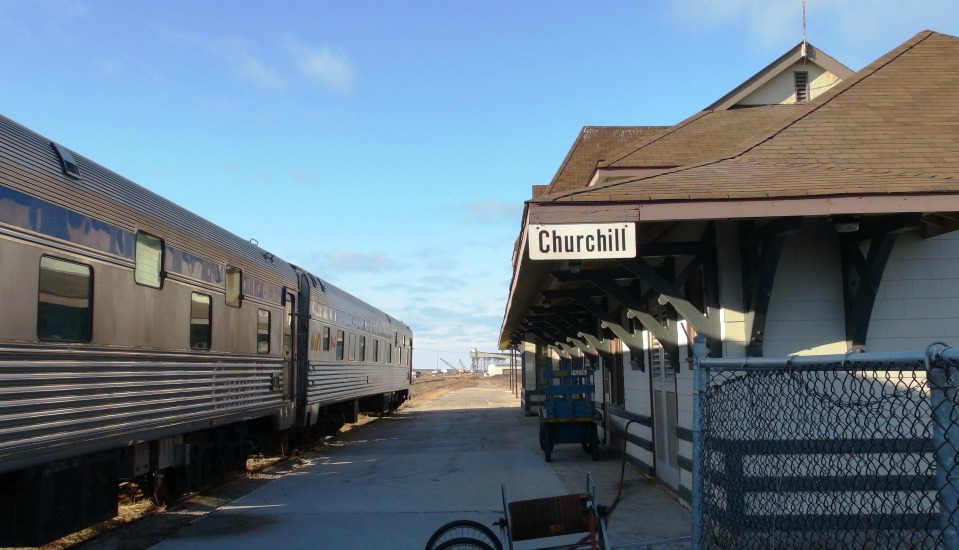by Steve Selden | Aug 19, 2016 | Tour News

Beluga whales would be adversely affected by oil spills in the Arctic. Alex De Vries – Magnifico photo.
The Province of Manitoba provided the final piece of the funding puzzle this week with a $9 million dollar pledge toward the projected $32 million Marine Observatory in Churchill. The main focus of the research carried out at the center will be on oil spills in the north and subsequent mitigation as well as prevention. Fragile Arctic and sub – Arctic wildlife and ecosystems will depend upon protection provided through this research station.
Lead scientist David Barber, a professor at University of Manitoba and Canada Research Chair in Arctic systems science, summarized the process leading up to this important announcement; “Everybody’s provided their funding, the project’s moving forward,” he stated. “We just need to finalize who’s going to build the thing. In the next 12 months we hope to get the building put together, functional and operating so it can be used for science .”
The funding will funnel through the University of Manitoba, the lead entity in this venture. A number of western Canadian universities and groups are involved in the massive coordination of budget and vision of the observatory. Manitoba’s commitment brings them all in line now.
With the recent closure of the Port of Churchill by US based Omnitrax, this announcement is a move in the right direction for the town of Churchill and prospective work – force. “This project is an important part of our vision for a strong, diversified northern economy,” stated Ian Wishart, the province’s Education and Training Minister.

Conceptual drawing of the Churchill Marine Observatory. Juliana Kusyk image.
“The Churchill Marine Observatory will create up to 21 permanent jobs, boost tourism and transportation in the region and enhance Manitoba and Canada’s reputation as a world leader in Arctic research,” added Wishart.
The project’s fundraising began in 2014 with three universities led by U of M applying to the Canadian Foundation for Innovation for almost 40 per cent of the needed $31.7 million. Manitoba, Aberta and British Columbia have contributed nearly $12 million with Manitoba being the stalwart at $9 million.
About 20 scientists will be based at the center in Churchill studying potential effects of oil and industry in the Arctic. Upon completion the Churchill Marine Observatory will provide a year – round base for new technology development and scientific research in the north. Universities from north America and Europe will utilize the center for student and faculty training and research as well.
by Steve Selden | Aug 8, 2016 | Churchill News

Tank farm and Port of Churchill in Churchill, Manitoba.
With all the talk surrounding the news of Omnitrax closing the Port of Churchill prior to the heart of the 2016 grain season, thus displacing nearly 200 jobs from Churchill to The Pas, nothing has come from the mouths of the company’s spokespeople.
Two weeks have passed since Omnitrax shut the port down and issued dozens of workers in Churchill alone their pink slips. However the premier of Manitoba, Brian Pallister, has not been contacted by the company or heard anything regarding the negotiations to sell the port to a first nations group. He has portrayed the lack of communication as a “mystery” and a “challenge” in the relationship between the government and Omnitrax.
Omnitrax has not made any statements or held any press conferences regarding the move and this has many officials in Canada baffled since the closure has drastically affected lives that rely on the employment as well as those in communities that live along the Bayline, also under the companies ownership. The rail line is key in supplying northern communities with goods and food products. Many settlements are not accessible by roads and rely heavily on the train as their main supplier. Omnitrax has plans to reduce the amount of freight to be shipped along its Bayline route. Although the train line remains operable, many are anxious as to its future viability in this situation
Oil transportation and shipping through the port has been a recent, hot issue initiated by Omnitrax. However, the initiative fell apart last year as overwhelming public resistance and outcry over the idea forced the company to back down. Some, including this writer, believe Omnitrax had its profit seeking sights set on this plan since day one. Now that the oil issue seems “dead in the water”, pardon the pun, the company has hit the road and headed back to Denver, Colorado.
Omnitrax had received a three dollar per tonne subsidy last year from Manitoba’s former NDP government but with the new Progressive Conservative party lead by Pallister, now in office no such bailouts were sanctioned for this year..
“The approaches that have been taken too often in the past have been alarmist and crisis in orientation, and that is not the nature of how we are going to build a stronger northern economy and stronger communities.” stated Pallister.
The situation is intriguing and continues to develop as this story is published. Stay tuned for updates from Churchill.
by Steve Selden | Aug 5, 2016 | Churchill News

Port of Churchill grain shipping operation on the Churchill River. Port of Churchill photo.
A northern delegation comprised of representatives from the Town of Churchill and The Pas, City of Thompson, Hudson Bay Route Association, and the War Lake First Nation have met with provincial and federal governments to try to sort out the recent Port of Churchill closure by american based owner Omnitrax. The company closed the port and issued two – week lay – off notices on July 25th of this year.
No grain has been shipped through the Port of Churchill prior to the shut – down in what Churchill Mayor Spence has characterized a “bumper -crop year”. The “unforseen” circumstances that Omnitrax is siting as reason for closure have still not been disclosed by the company that purchased the facility in 1993 from the Government of Canada which was at the time divesting itself from numerous crown corporations. The current closure affects nearly 200 paid positions all along the Bayline.
Speaking for the northern delegation, Mayor Spence stated “this is an emergency situation for our community, our region and indeed our country. We’ve been told by farmers that there is a bumper crop and as an export country we can’t be shutting down ports if we are able to keep people employed and grow our economy”.
The delegation is in agreement that the Government of Canada at national and regional levels should take responsibility to insure that the Port of Churchill is of national interest. In this light all involved feel the Port of Churchill needs to be reopened and continue to function as a part of Canada’s national infrastructure. This new delegation has pledged to continue to diligently work with the branches of government to find a long term solution for keeping the port operations running.
Michael Constant, Chief of the Opaskwayak Cree Nation, reinforced the message by Mayor Mike Spence of Churchill stating “we have all come together to find a workable long term solution and we are prepared to advance a northern regional ownership model that we feel is the best approach going forward”.
Last December a group of Manitoba First Nations purportedly was in the process of finalizing an agreement to purchase the Port of Churchill though that news has simmered somewhat as no definitive sale has been finalized.
by Steve Selden | Jun 30, 2016 | Churchill News, Churchill Photography

New synthetic turf in the Churchill town square. Alex De Vries – Magnifico photo.
Churchill is moving into the 21st Century with a new synthetic turf field for the town square behind the chamber of commerce information kiosk. Looking more like an artist’s depiction than the real thing, this image from Alex De Vries – Magnifico in Churchill shows the newly “mowed” field. The old field and town “green” was far from that with hard dirt and scattered rocks throughout. This will hopefully encourage the youth and adult population to participate in sports such as baseball and soccer throughout the summer months. The field will be finished just in time for Canada Day on July 1st and the annual ball tournament and other festivities!
I can’t help thinking of a funny Canada Day story that occurred when I was guiding Churchill Arctic Summer trips years ago. When I first started I would stay in Churchill and await the arrival of the group on the VIA Rail train with my Natural Habitat Adventures co-guide. Once they arrived we would guide travelers across the tundra in search of flowers and wildlife and over the waters of the Hudson Bay and Churchill River to see the beluga whales. The amazing biosphere of Churchill would be home for the next five days. At the end of the trip my co-guide would return to Winnipeg with the group by air and return a few days later by train. Not a bad gig!

Churchill’s Via rail station with a train at the dock. Cartan Tours photo.
Train arrivals in those days, much like train arrivals these days, were often three – four hours late. Due to the warm weather and shifting permafrost in the summer months, trains would be issued “slow” orders that would only permit them to travel at recommended slow speed so to not place undo stress on the steel rails. Unfortunately, overloaded grain cargo trains heading to the Port of Churchill often disregarded the slow orders and periodically derailed in front of the passenger trains. These accidents caused huge delays and sometimes the necessity to reroute travelers on flights to Churchill or bus to get to a bigger town to wait out the track repairs. Not much has changed there either. All part of the adventure.
Churchill was putting on its usual festivities and I was taking part in the annual town softball tournament. Teams from the Churchill Northern Studies Center, the hospital, restaurants, Parcs Canada and just friends putting a team together were all enjoying the friendly competition on the diamond. Throughout the morning of the tournament, the train’s late – arrival had been updated numerous times and last I heard estimated to arrive in Churchill at roughly 3:00 pm. I came to learn that “roughly” in Churchill is all part of a vernacular we often refer to as “tundra time”.
Our game was going on around 1:30 pm and I was in my softball attire of sweats and a t-shirt, up at bat with the softball at the apex of its arc when I heard the train’s horn blowing loudly across the square. After raking a base – hit to right field (actually the aforementioned dirt and rocks) I glanced over to see the train limping into the station and I ran. Not towards first base but instead toward the Seaport Hotel to my room to change into proper Nat Hab guide attire and then cruise over to the station and meet the arriving group! I received lots of ribbing from the team for that panicky though funny exit…still makes me laugh to this day. Never trust the train schedule or rumors to its arrival in Churchill. Tundra time indeed!

Canada Day is on July 1st. Here’s an itinerary of the events planned. Town of Churchill image.
by Steve Selden | Feb 17, 2016 | Churchill News

Port of Churchill grain shipping operation on the Churchill River. Port of Churchill photo.
Canadian Prairie farmers from Manitoba and Saskatchewan have decided to press for the reestablishment of a the Canadian Wheat board, a single-desk system for marketing their grain to various world markets.
Over 50 farmers from the Pelly and Swan River areas of Saskatchewan and Manitoba met last week and passed a unanimous resolution requesting the re-establishment of the Canadian Wheat Board according to the Canadian Wheat Board Alliance.
The group says the loss of the Coordinating core board has lead to an increasingly disorganized, hap – hazard rail system, inconsistent grain quality guarantees for other nations and an $6.5 billion overall income loss for farmers over the past two years.
For more than 70 years, prairie farmers were forced to sell their grains to the CWB, which then would export it to foreign markets.Former agriculture Minister Gerry Ritz passed legislation ending the Canadian Wheat Board in 2012, and last year half of its assets were ultimately sold off to Saudi-owned G-3 Global Grain Group.
Ritz at the time had this to say: “Overall, logistics have been good,” said Ritz. “We’re seeing market share in premium markets going up. We’ve had no problem at all when we’re talking free trade agreements with other countries, they welcome the opportunity to buy more Canadian wheat. Apparently things are not going as planned.
However, with he Port of Churchill under consideration for purchase by a native group in Canada from current owner Omnitrax, this possible “renewed” direction could bode well for more consistent shipping from the Arctic port.








